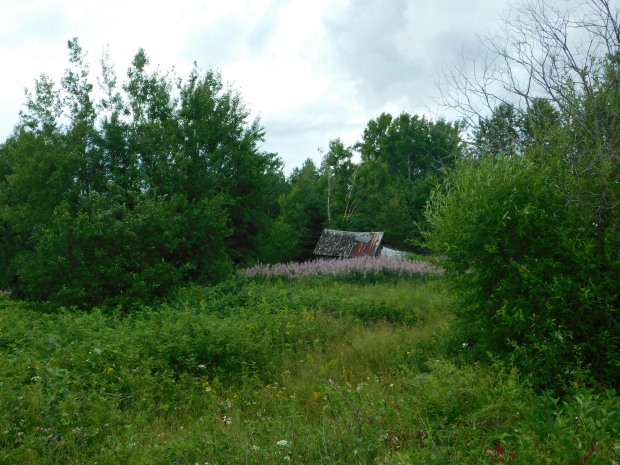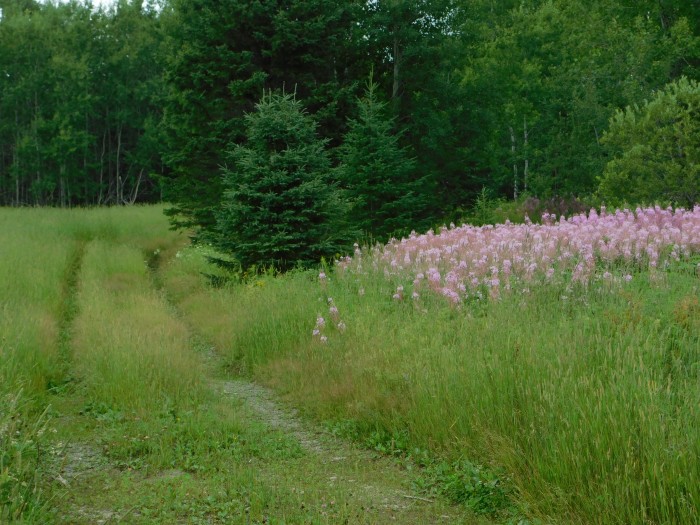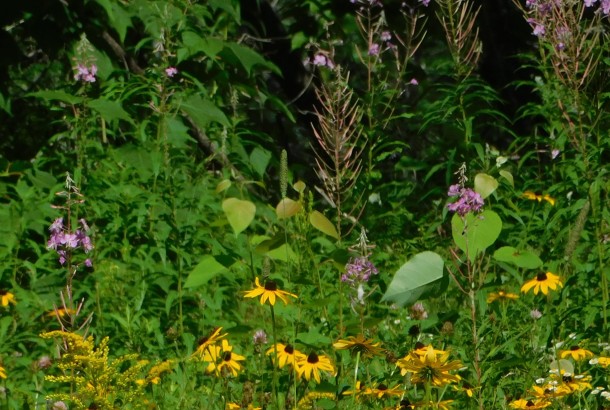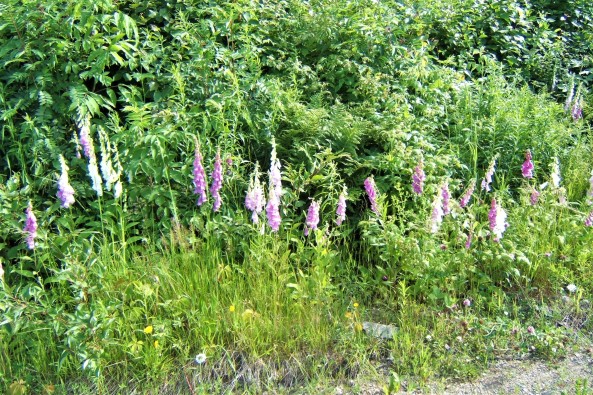abandoned spaces: fireweed
Lately, I have been thinking a lot about abandoned rural areas and the remnants of gardens left behind. Although these properties are still owned, the homes that once stood there are gone or left to deteriorate. The gardens, once loved and cared for, are left to survive on their own.
~
When these home-sites are abandoned, the garden plants:
- disappear (most annuals),
- persist (perennials like day-lilies or roses), or
- escape (lupins, mallow or other easily-spreading plants).
Native plants, those liking disturbed or cleared areas, may move into these sites.
~

an abandoned site in Williamsburg, New Brunswick where fireweed has colonized
~
As I find abandoned properties, the pink or pale purple flowers of fireweed are often present. Fireweed, an indigenous plant not usually grown in gardens, is often a first indicator a house may once have stood on a plot of land. Often fireweed stands side by side with orange day-lilies and other garden escapes.
~

on this abandoned site in the Williamsburg area, the fireweed stands side-by-side with orange day-lilies (Hemerocallis fulva), rose bushes and other cultivated plants
~
Fireweed (Epilobium angustifolium L.), also known as great willowherb, gets the ‘fire’ in its name since it is one of the first plants to colonize after fire. As a pioneer species, partial to open areas with lots of light, it also moves in to any cleared or disturbed area. After a few years, other plants will move in, out-competing the fireweed. However, the seeds of fireweed stay viable for a long time and may re-colonize the area if it is again disturbed or burned.
~
Fireweed is one of many tall pinkish flowers growing in our ditches and wild areas. It is distinguished by its rather loose inflorescence, the flower’s four roundish petals and its seed pods which angle upwards.
~

~
Fireweed spreads by the roots or by seed. In the later part of the season, the seeds are spread by the wind, aided by long silky hairs. Before dispersal the hairy seeds burst out along the seed pods making the plant look unkempt and hairy.
~

Fireweed (pink) among brown-eyed Susans; the stiff, many-podded plants in the upper right-hand corner are the seedpods of fireweed, finished with their blooming
~
In New Brunswick we are facing a demographic trend of movement from rural communities to cities in the southern part of the province and elsewhere. This means many small communities that thrived a century ago are now abandoned. For example, in 1866 the community of Fredericksburg, New Brunswick was a farming community with 12 families (Source: https://archives.gnb.ca/Exhibits/Communities/Details.aspx?culture=en-CA&community=1367 ). Today only a couple of homes or camps are found in the area but foxglove flowers, that once bloomed in the gardens, thrive in the ditches. For more on the demographics of small New Brunswick communities see:
Lauren Beck and Christina Ionescu. ‘Challenges and Opportunities Faced by Small Communities in New Brunswick: An Introduction’, Journal of New Brunswick Studies Issue 6, No. 1 (2015).
https://journals.lib.unb.ca/index.php/JNBS/article/view/23057
~

foxglove (Digitalis purpurea) flowers thriving in the ditch in the Fredericksburg area
~
All my best,
Jane




















So interesting, Jane! I am fascinated with abandoned places and structures. It is amazing how nature reclaims a space. I’m sorry to hear that the rural areas are being abandoned though. I guess economically it doesn’t make sense to farm any more?
LikeLiked by 1 person
Meg
August 3, 2018 at 9:07 am
Farms are getting bigger and more mechanized. In rural areas of New Brunswick, people live not only as farmers, but in the fishing and forest industries, as well as community support like grocers. These are tough lives and many young people either can’t find work or want a better life. Sometimes communities are so isolated, they struggle to get services in winter. Some government policies such as closing down local schools and hospitals contribute to people moving to urban areas.
LikeLiked by 1 person
jane tims
August 3, 2018 at 11:23 pm
Oh boy… that’s really a shame. Losing a whole way of life. And it only gets worse as more people leave. Small farms have been reclaimed by the forest in places like New Hamshpire. But the migration of those farmers happened a long time ago.
LikeLiked by 1 person
Meg
August 4, 2018 at 10:30 am